For commercial painting contractors, mastering the art of application is essential to achieving a flawless finish, maximizing efficiency, and ensuring client satisfaction. Among the many coating application tools available, air spray guns stand out as a go-to technology, widely adopted across diverse industries for their versatility and precision. This guide takes a look into the world of air spray guns, their basic operations, distinctive characteristics, and nuances of their most common uses.
At its core, an air spray gun utilizes compressed air to atomize liquid coatings into a fine mist, propelling it towards the target surface. This process of atomization, breaking down the liquid into tiny droplets, is crucial for achieving a smooth, even, and professional-grade finish. The magic of air spray guns, and a primary reason for their widespread popularity, lies in the ability to finely control this atomization through precise air pressure settings and various air cap options.
Unlike other spray technologies where fine-tuning may involve complex adjustments, air spray guns achieve optimal performance based on adjusting the air pressure. Higher air pressure generally leads to finer atomization, creating smaller droplets and a smoother finish. However, this must be balanced with transfer efficiency – the proportion of coating material that actually lands on the target surface. Too much air pressure can lead to overspray, wasting material, and increasing cleanup.
Finding that sweet spot where atomization is maximized for a superior finish while simultaneously ensuring high transfer efficiency is the hallmark of a skilled operator and the key to unlocking the full potential of air spray technology.
Questions You Should Be Asking In Your Purchasing Process
Beyond the technology, consider how a new air spray gun can address existing pain points in your finishing operations, such as high reject rates or material waste. The starting point in any discussion about spray guns or anything equipment-related begins with what you are trying to accomplish. Yes, it’s a finishing application. But new equipment should help you be more efficient, through more output or less waste or both.
When considering an air spray gun, ask yourself: What are your specific finishing goals? Are your current air spray tools optimized for efficiency? Do your operators follow best practices for air spray equipment maintenance? You should consider consulting with the experts at Spray Equipment & Service Center.
We learn about your operation from multiple perspectives to ensure we uncover every opportunity for output, efficiency, and savings. We work backward from your process, manufacturing routine, and output goals to form the basis for our recommendation, whether it’s replacing a spray gun or designing a custom-crafted solution. We focus on the results most important to you and your business goals. Our experts will help you arrive at the best possible solution.
Types of Air Spray Guns
While all air spray guns share the common principle of air-powered atomization, several distinct types have evolved to meet specific application demands. Understanding these differences is crucial for selecting the right tool for the job.
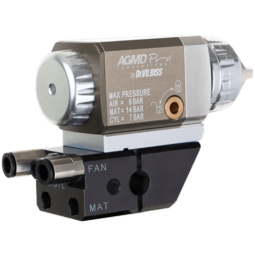
Conventional Air Spray Guns
Conventional air spray guns operate at higher air pressures (typically 30-80 PSI at the cap) and require significant airflow. They are known for their powerful atomization and ability to handle a wide range of material viscosities.
Ideal Applications: These guns are often used for general-purpose painting, particularly when speed and the ability to atomize thicker materials are priorities. They excel in industrial settings, automotive repair, and woodworking.
Advantages: Excellent atomization, high production speed, ability to spray a wide variety of materials, and a smooth finish.
Disadvantages: Lower transfer efficiency due to significant overspray, leading to more material waste and increased environmental concerns. They also require more overspray mitigation and cleanup.
Common Materials and Substrates: Primers, lacquers, enamels, and stains on wood, metal, and some plastics.
Compliant Air Spray Guns
Compliant spray guns are designed to meet specific environmental regulations (like those set by the EPA) for reduced volatile organic compound (VOC) emissions. They achieve this by operating at lower atomization pressures while still aiming for a good finish quality. They are a bridge between conventional and HVLP technologies.
Ideal Applications: General finishing, automotive refinishing, and industrial applications where environmental regulations are a concern but a quality finish is still required.
Advantages: Improved transfer efficiency compared to conventional guns, reduced overspray, and compliance with environmental regulations.
Disadvantages: May not atomize extremely thick materials as finely as conventional guns, and can be slightly slower in application speed.
Common Materials and Substrates: Automotive clear coats, base coats, and various industrial coatings on metal and composite surfaces.
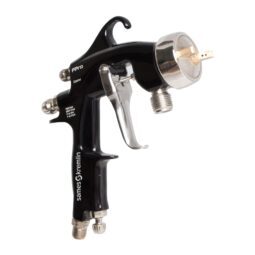
HVLP Air Spray Guns
High Volume Low Pressure (HVLP) guns operate with a high volume of air at very low pressure (typically 10 PSI or less at the air cap). This low pressure significantly reduces overspray while still providing excellent atomization.
Ideal Applications: HVLP guns are widely used in automotive refinishing, fine woodworking, furniture finishing, and general contracting, where high transfer efficiency and a smooth finish are critical.
Advantages: Exceptional transfer efficiency (often 65% or higher), minimal overspray, significant material savings, reduced environmental impact, and less need for extensive masking.
Disadvantages: Can be slower than conventional guns, may struggle with very high viscosity materials without proper thinning, and require a greater volume of compressed air.
Common Materials and Substrates: Waterborne and solvent-based paints, lacquers, stains, and clear coats on wood, metal, plastics, and various automotive components.
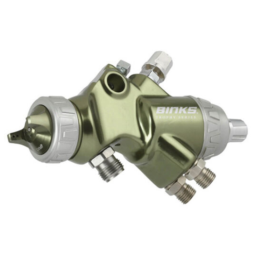
LVMP Air Spray Guns
Low Volume Medium Pressure (LVMP) guns represent a hybrid technology, combining aspects of both conventional and HVLP systems. They use a lower volume of air than conventional guns but at a higher pressure than HVLP (typically 10-20 PSI at the cap). This allows for faster application than HVLP while still maintaining good transfer efficiency.
Ideal Applications: LVMP guns are gaining popularity in automotive refinishing, industrial painting, and general contracting where a balance between speed, finish quality, and transfer efficiency is desired.
Advantages: Faster application speed than HVLP, improved transfer efficiency compared to conventional guns, and good atomization for a smooth finish.
Disadvantages: Transfer efficiency may not be as high as HVLP, and they still produce more overspray than true HVLP systems.
Common Materials and Substrates: Automotive topcoats, industrial enamels, and various primers on metal and composite surfaces.
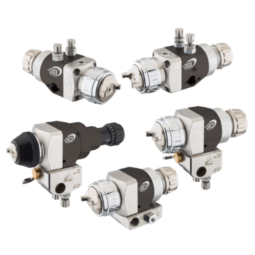
Trans Tech Air Spray Guns
Trans Tech (also known as RP - Reduced Pressure) guns are a proprietary technology developed by DeVilbiss, focusing on achieving high transfer efficiency at reduced air pressure while maintaining a spray pattern similar to conventional guns. They are designed to meet environmental regulations while offering excellent atomization and speed.
Ideal Applications: Primarily used in automotive refinishing and high-production industrial applications where speed, finish quality, and compliance with environmental regulations are paramount.
Advantages: High transfer efficiency (often comparable to HVLP), fast application speed, excellent atomization, and a wide fan pattern, making them very productive.
Disadvantages: Can be more expensive than other types, and their performance is highly dependent on proper setup and air supply.
Common Materials and Substrates: Automotive clear coats, base coats, and various industrial topcoats on metal and composite surfaces.
Leading Air Spray Guns
Stellair Air Spray Gun, Conventional
The Graco Stellair Air Spray Gun, featuring a 0.055 inch (1.4 mm) fluid nozzle, is a conventional air spray gun designed for general industrial applications. This robust and versatile sprayer is engineered for reliable performance across a broad spectrum of coatings commonly used in manufacturing and fabrication.
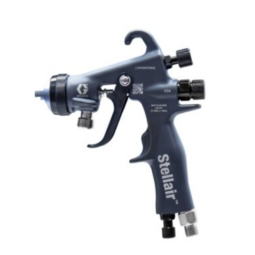
Operating on conventional air spray principles, the Stellair provides powerful atomization, making it suitable for a wide range of material viscosities. The 1.4 mm nozzle is a common size for achieving a good balance between material flow and atomization for general-purpose finishes. Its straightforward design allows for easy maintenance and reliable operation in demanding industrial environments.
While designed for efficiency in general industry, users should note that as a conventional air spray gun, it will exhibit the typical characteristics of this technology, including higher air pressure requirements and a focus on effective atomization for a smooth finish. This gun is a workhorse for applications where material versatility and a consistent finish are key.
Binks DVX Manual Air Spray Gun
The Binks DVX series features an innovative redesign of the fluid body and air caps. This advanced architecture effectively manages turbulence between paint and air during application, leading to superior flow rates for rapid completion of tasks, enhanced transfer efficiency for material conservation, and the most consistent spray pattern available. These guns are engineered for improved balance and ergonomics, designed to keep pace with any painter's demands. The DVX series offers both pressure-feed and gravity-feed options.
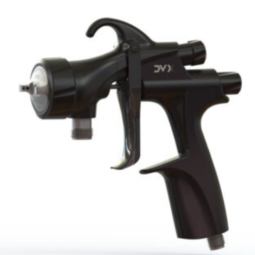
The groundbreaking design contributes to the best air spray finish quality on the market by eliminating areas that typically create compression, separation, and stagnation zones, which result in orange peel effect and mottling. A quick-release hard-anodized air cap retaining ring allows for fast and easy cap removal with less than a full-turn rotation, minimizing downtime. The guns achieve a 15% reduction in material use compared to other non-electrostatic air spray applications and can operate efficiently at both low and high inlet air pressures.
Ideal Applications: Low-pressure air spray applications where high flow rates, material efficiency, consistent patterns, and superior finish quality are paramount. This includes professional automotive refinishing, furniture, and general industrial coatings.
Common Materials & Substrates: A wide array of liquid coatings, including waterborne, solventborne, high solid urethanes, epoxies, and enamels on various surfaces such as wood, metal, and composites.
Why Buy from Spray Equipment & Service Center?
With all of the potential technologies to consider and variables involved, selecting an air spray gun can be a bit overwhelming. We are happy to help you find the right air spray gun for your needs.
We are your trusted partner for all things Spray. Our service is the same regardless of the technology you buy. We provide added value through:
Advice: Our experience, expertise and approach work for you at every stage
Supply: We have the right equipment and parts
Service: We are just a phone call (800-666-6072) away. Or here for a live chat. In any case, we will be with you for a long time.
